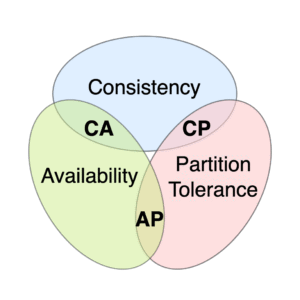CAP Theorem (Consistency, Availability, Partition Tolerance)
The CAP Theorem is a fundamental concept in distributed database systems. It states that in the presence of a network partition, a distributed system can guarantee only two out of the three properties: Consistency, Availability, and Partition Tolerance. Understanding this helps students make informed design decisions when building scalable applications.
The Three Components of CAP
1. Consistency
- Every read receives the most recent write or an error.
- All nodes in the system reflect the same data at any given time.
- Example: If you write data to one server, and immediately read from another, you should get the same result.
- Think of it like the consistency in traditional RDBMS databases (like SQL).
2. Availability
- Every request (read or write) gets a non-error response, even if it’s not the latest version.
- The system remains operational all the time, even during network failures.
- Example: If a node is down, the system should still respond using other available nodes.
- Availability prioritizes uptime over strict data accuracy.
3. Partition Tolerance
- The system continues to operate despite network partitions (communication failure between nodes).
- In distributed systems, network partitions are inevitable, so partition tolerance is essential.
- Example: Even if messages between servers are delayed or lost, the system should still work in some form.
CAP Triangle – The Trade-Off
The CAP Theorem says that a distributed system cannot achieve all three properties simultaneously. It must sacrifice one when a partition occurs. In real-world systems, partition tolerance is generally non-negotiable, so developers must choose between Consistency and Availability.
Here’s how the combinations work:
| Combination | Meaning | Real-World Example |
|---|---|---|
| CA (No Partition Tolerance) | Strong consistency and availability, but cannot handle network partitions | Traditional single-node databases |
| CP (No Availability) | Consistent and partition-tolerant, but might reject requests during failure | HBase |
| AP (No Consistency) | Available and partition-tolerant, but may return outdated data | Cassandra, Couchbase, DynamoDB |
In distributed systems, especially in cloud and NoSQL setups, we typically design for AP or CP.
Why It Matters for Projects
When building projects involving distributed storage, cloud platforms, or real-time data, understanding the CAP theorem helps in:
- Selecting the right database system (SQL vs. NoSQL)
- Designing failover strategies
- Balancing user experience with data accuracy
- Communicating trade-offs to stakeholders
